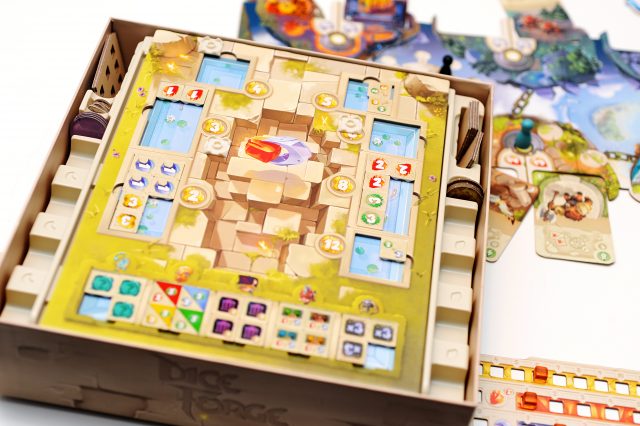Every once in a while, a game will come along built around a neat new mechanic and almost get it right. That was the case with Rattlebones. It’s a fun little carnival themed game that introduces dice crafting. While I found the game fun, I could help but feel it didn’t live up to the potential of the mechanic. It was only a matter of time.
 In Dice Forge, the gods have decided to elect a new demi-god, and they’re holding a tournament to determine who gets the honour. Players will get divine blessings and be faced with heroic feats over the course of ten rounds.
In Dice Forge, the gods have decided to elect a new demi-god, and they’re holding a tournament to determine who gets the honour. Players will get divine blessings and be faced with heroic feats over the course of ten rounds.
Games of Dice Forge feel like they’re flying by. In part because they are quite quick, but the game also does an excellent job of keeping players involved at all times.
Everyone starts with the same two dice. One has five faces earning you one gold piece and one face that will earn you a Sun Shard. The other has four faces that will earn one gold, one that earns you a Moon Shard, and one that will earn you two points.
In each of the rounds, players will take turns being the active player. However, each turn everyone rolls their dice and collects the resources (divine blessing). So, if I’m player three, I’m going to get to roll three times before my turn.
 Resources are tracked on easy to read personal boards. With cubes going up and down as you earn and spend resources.
Resources are tracked on easy to read personal boards. With cubes going up and down as you earn and spend resources.
Once everyone has received their divine blessing, the active player can either visit the Temple to forge their dice or complete a heroic feat. Forging your dice is really the meat of the game. You spend gold to choose a new face or faces for your dice. The more you spend, the better the face will be. Most will earn you resources like Sun or Moon Shards, gold, or points, or choice or combination of them.
When you buy a new face, you choose which dice to use them on, and which face you want to replace. By pushing the new face under the old one, they pop out pretty easily. Very quickly people’s strategies will take shape as they  construct their dice. It has almost a Dominion-like feel as you alter your starting pieces to increase your potential for certain outcomes.
construct their dice. It has almost a Dominion-like feel as you alter your starting pieces to increase your potential for certain outcomes.
The gods have also set up heroic feats on different floating islands for players to complete. These feats are represented by cards and the islands are represented on the board. To complete one of the feats, players move their pawn to the appropriate space on the board and spend the resources required to gain the card. These can yield immediate or ongoing bonuses, major points, or even attack the other players. Some of the feats will even give the opportunity to forge your dice, like the Helmet of Invisibility which gives you the 3x face (allowing you to multiply the dice it’s paired with) or the Mirror of the Abyss that gives you the mirror face (allowing you to mirror the die results of one of your opponents).
Deciding when to make a move that will improve your dice and when to complete feats is an important one. Both have strong potential benefits.
The game ends after the tenth round, with everyone totalling their points earned for dice rolls and cards. Earn the most points and hey! You’re a demi-god! Congrats!
 I really have to mention the incredible production value of this game. With a mechanic gimmick like interchangeable dice faces, it could very easily have gone wrong. However, the big chunky dice work perfectly. Faces can be changed really easily and stick in well once put in place. The Temple works beautifully as a holding place for the potential faces that you can buy and the sleeve that it is held in is a quick reference guide for where those pieces go during clean up. The art on the cards is pretty and the iconography is easy to read.
I really have to mention the incredible production value of this game. With a mechanic gimmick like interchangeable dice faces, it could very easily have gone wrong. However, the big chunky dice work perfectly. Faces can be changed really easily and stick in well once put in place. The Temple works beautifully as a holding place for the potential faces that you can buy and the sleeve that it is held in is a quick reference guide for where those pieces go during clean up. The art on the cards is pretty and the iconography is easy to read.
I must say that I really like Dice Forge. It seems to live up to the potential that Rattlebones promised with the dice crafting mechanic. It’s not a crazily deep game, but you really wouldn’t expect that from a game that relies so heavily on dice rolling. And of course it goes without saying that if you’re not into dice games this is not a title for you.
Comments
No comments yet! Be the first!